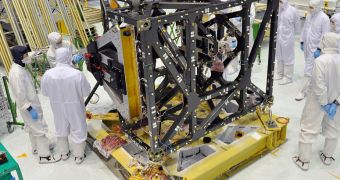The first of the next generation of space telescopes has just underwent a new series of extreme tests, meant to assess whether or not it's ready to endure the bumpy road to space. The chassis of the new instrument passed the assessments with flying colors.
The James Webb Space Telescope (JWST), a joint endeavor of NASA and the European Space Agency (ESA) is the most complex piece of equipment to be sent to space. It also features a number of technological firsts, and this is why testing it thoroughly is critical.
At the very heart of the observatory is the Integrated Science Instrument Module (ISIM), which plays the same role a chassis does to a car. It provides support for all the scientific payloads that will go on the JWST, as well as for other electronic components.
It will also support the engines, thrusters, heat shields and the primary mirror. Everything on the telescope will be within, or attached to, the ISIM. As such, the new tests were aimed at analyzing whether the component is prepared to receive all of its payloads.
The JWST is at this point scheduled to launch to space aboard an Ariane 5 heavy-lift delivery system, provided by constructor Arianespace in cooperation with ESA. This rocket has a near-perfect launch history, with only 2 failed attempts ever.
Given the size of the rocket, the ISIM will be subjected to a lot of vibrations, that could damage its structural integrity. In order to ensure that no damage will come to the chassis and its payload, scientists at the Goddard Space Flight Center (GSFC) are putting the ISIM through its paces.
They are spinning and shaking it like crazy. At the same time, sensors are picking up the locations at which stress builds up, so that researchers can get a clear view of the most vulnerable areas.
The results obtained in these tests are then compared to computer simulations of the completed JWST, and engineers go on to analyze any potential discrepancies. After the issues are fixed, the process is repeated until the real-life readings are consistent with the models.
Every aspect of this telescope is critically-important, if the instrument is to reach its goal of seeing the first light of the Universe. It will also be able to see the first galaxies and stars that ever developed, and to confirm some findings made with other advanced telescopes.
At this point, the JWST is scheduled to be completed and launched by June 2014 or mid-2015. The sheer number of new technologies that need to work together to make this mission a success makes it very difficult to predict an accurate launch date so long in advance.

 14 DAY TRIAL //
14 DAY TRIAL //